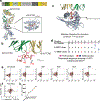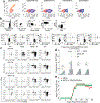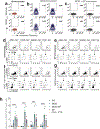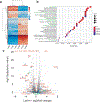Opposing T cell responses in experimental autoimmune encephalomyelitis
- PMID: 31391585
- PMCID: PMC7145319
- DOI: 10.1038/s41586-019-1467-x
Opposing T cell responses in experimental autoimmune encephalomyelitis
Abstract
Experimental autoimmune encephalomyelitis is a model for multiple sclerosis. Here we show that induction generates successive waves of clonally expanded CD4+, CD8+ and γδ+ T cells in the blood and central nervous system, similar to gluten-challenge studies of patients with coeliac disease. We also find major expansions of CD8+ T cells in patients with multiple sclerosis. In autoimmune encephalomyelitis, we find that most expanded CD4+ T cells are specific for the inducing myelin peptide MOG35-55. By contrast, surrogate peptides derived from a yeast peptide major histocompatibility complex library of some of the clonally expanded CD8+ T cells inhibit disease by suppressing the proliferation of MOG-specific CD4+ T cells. These results suggest that the induction of autoreactive CD4+ T cells triggers an opposing mobilization of regulatory CD8+ T cells.
Conflict of interest statement
All authors declare no competing interests.
Figures
















Comment in
-
Regulatory T cells subdue an autoimmune disease.Nature. 2019 Aug;572(7770):443-445. doi: 10.1038/d41586-019-02271-7. Nature. 2019. PMID: 31427795 No abstract available.
References
-
- Fallang L-E et al. Differences in the risk of celiac disease associated with HLA-DQ2.5 or HLA-DQ2.2 are related to sustained gluten antigen presentation. Nat. Immunol. 10, 1096–1101 (2009). - PubMed
-
- Zamvil S et al. T-cell clones specific for myelin basic protein induce chronic relapsing paralysis and demyelination. Nature 317, 355–358 (1985). - PubMed
Publication types
MeSH terms
Substances
Grants and funding
LinkOut - more resources
Full Text Sources
Other Literature Sources
Molecular Biology Databases
Research Materials

